The “Problem” of New Orleans and Diminishing Sustainability of Mississippi River Management—Future Options
Abstract
1. Introduction
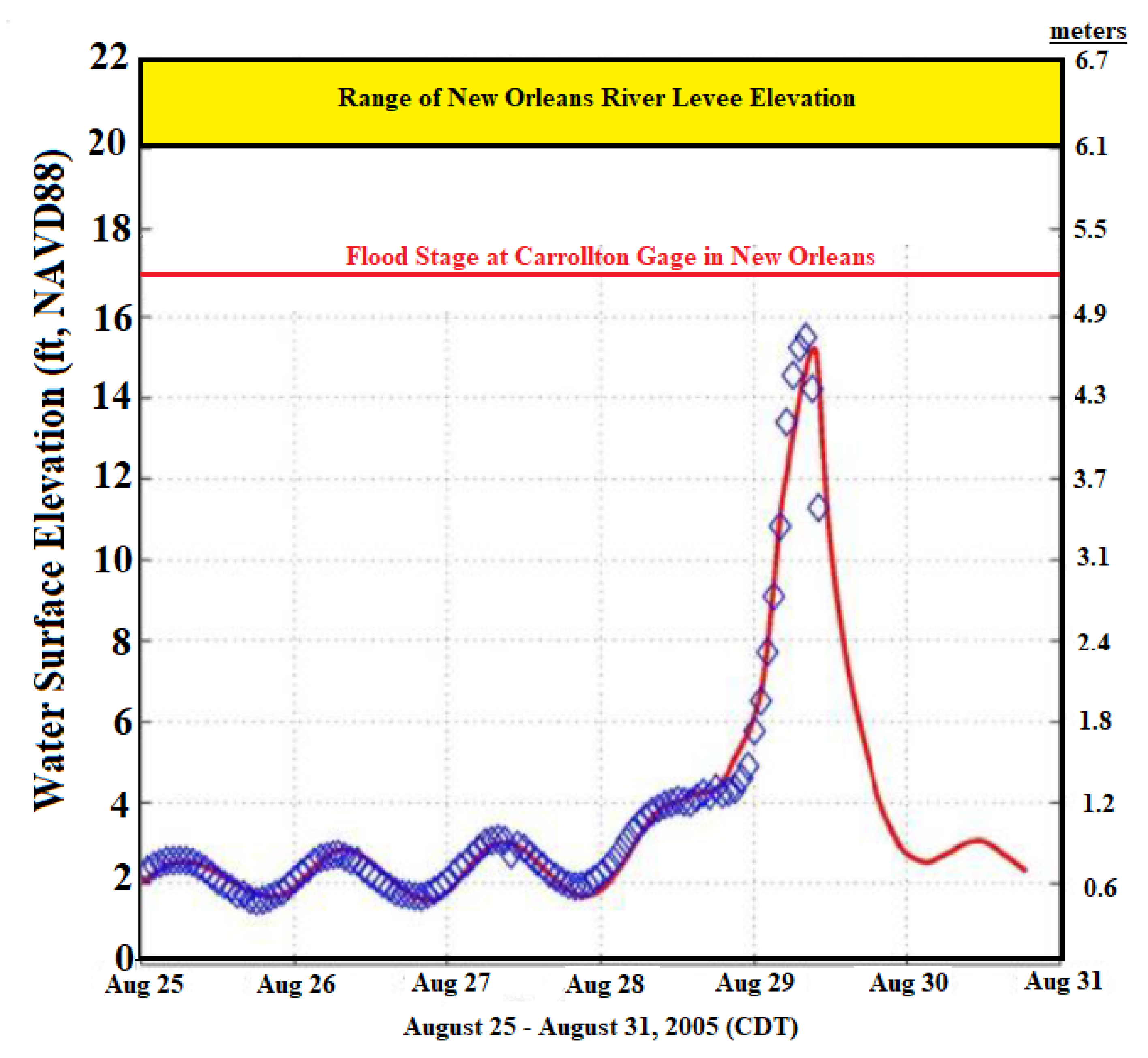
2. The Mississippi River Flood Control System—Past Development and Future Prospects
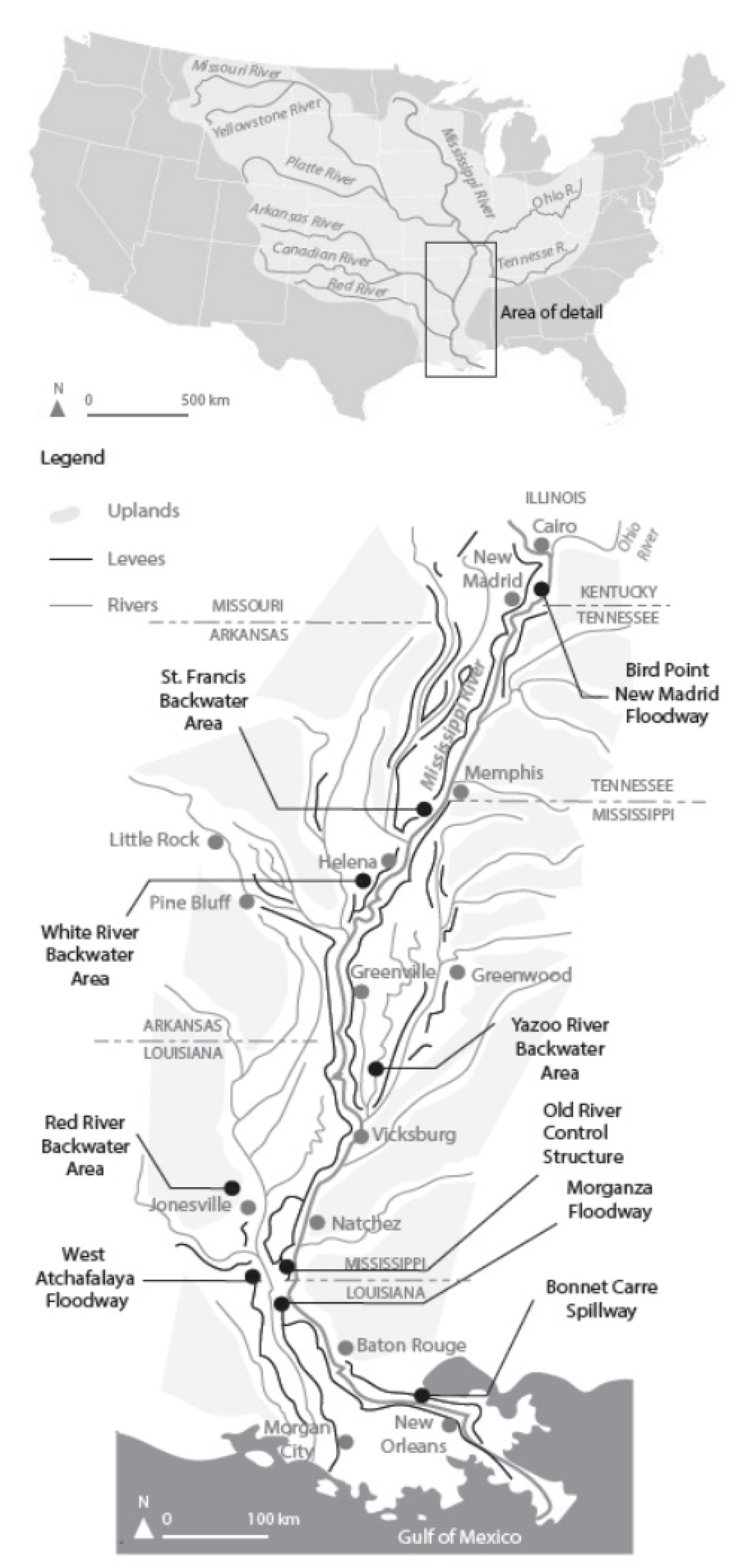
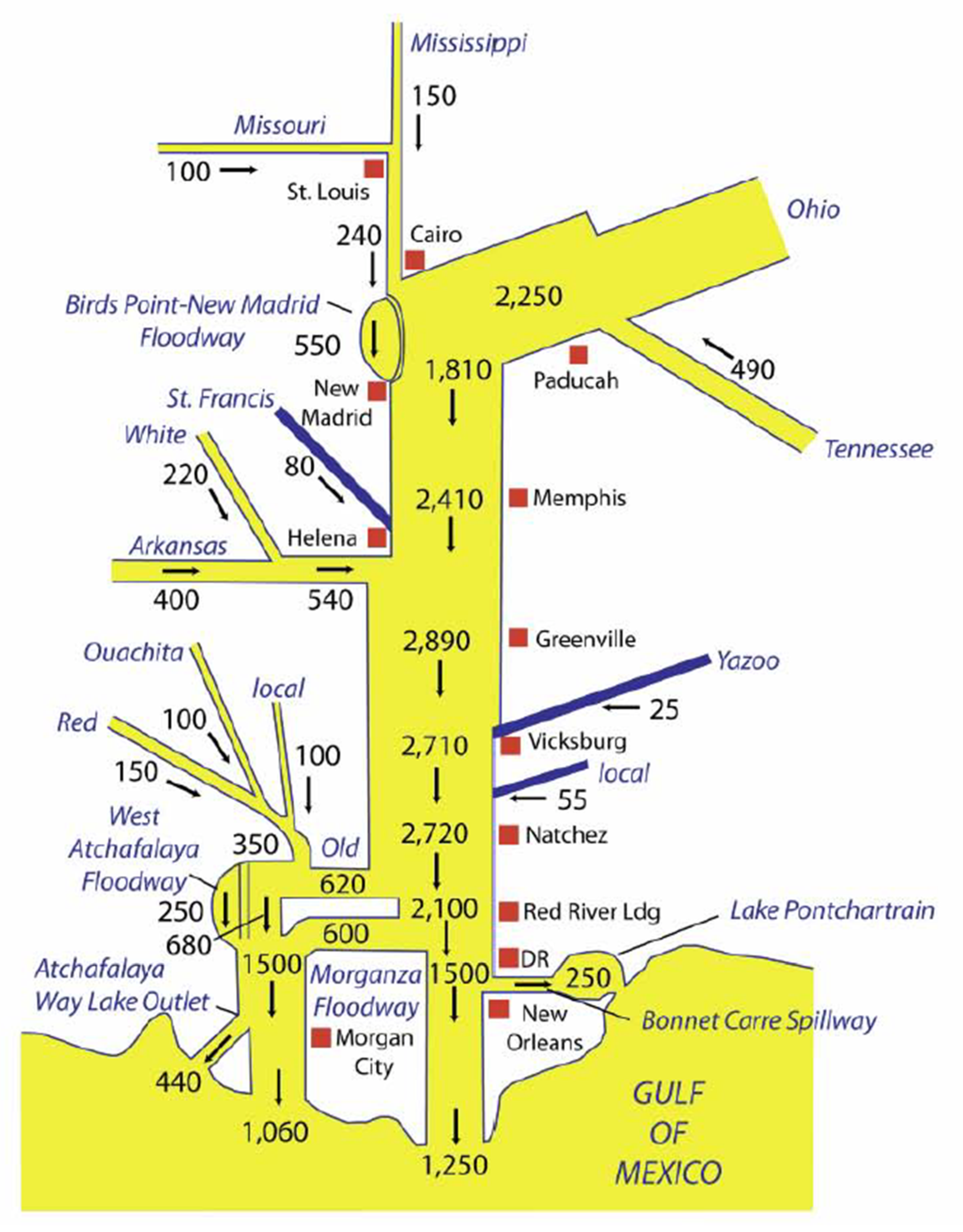
3. Extreme Precipitation Events
4. A Sustainable New Orleans
5. Stormwater Drainage in the New Orleans Metro Area
- How many pumps are running (an estimated 10 to 15 pumps are down for maintenance at any one time);
- Location—(e.g., how far the area is from a pump, drain times vary by street);
- Amount and rate of rainfall;
- Amount of impervious surfaces (affects runoff vs infiltration)
- Frequency of storms;
- and Soil saturation.
6. Future Management of the Lower Mississippi River Flood Control and Navigation System
7. The Potential to Increase Basin Sediment Input
8. Planning for Global Change
Author Contributions
Funding
Institutional Review Board Statement
Informed Consent Statement
Data Availability Statement
Conflicts of Interest
References
- Coastal Protection and Restoration Authority of Louisiana (CPRA). Louisiana’s Comprehensive Master Plan for a Sustainable Coast; CPRA: Baton Rouge, LA, USA, 2017. Available online: https://coastal.la.gov/our-plan/2017-coastal-master-plan/ (accessed on 20 January 2021).
- Wiegman, A.; Rutherford, J.; Day, J. The costs and sustainability of ongoing efforts to restore and protect Louisiana’s coast. In Mississippi Delta Restoration; Day, J., Erdman, J., Eds.; Springer: New York, NY, USA, 2018; pp. 93–111. [Google Scholar]
- Day, J.; Rybczyk, J. Global change Impacts on the future of coastal systems: Perverse interactions among climate change, ecosystem degradation, energy scarcity and population. In Coasts and Estuaries-The Future; Wolanski, E., Day, J., Elliott, M., Ramach-andran, R., Eds.; Elsevier: Amsterdam, The Netherlands, 2019; pp. 635–654. [Google Scholar]
- Syvitski, J.P.M.; Kettner, A.J.; Overeem, I.; Hutton, E.W.H.; Hannon, M.T.; Brakenridge, G.R.; Day, J.; Vorosmarty, C.; Saito, Y.; Giosan, L.; et al. Sinking deltas due to human activities. Nat. Geosci. 2009, 2, 681–686. [Google Scholar] [CrossRef]
- Renaud, F.G.; Syvitski, J.P.M.; Sebesvari, Z.; Werners, S.E.; Kremer, H.; Kuenzer, C.; Ramesh, R.; Jeuken, A.; Friedrich, J. Tipping from the Holocene to the anthropocene: How threatened are major world deltas? Curr. Opin. Env. Sustain. 2013, 5, 644–654. [Google Scholar] [CrossRef]
- Giosan, L.; Syvitski, J.; Constantinescu, S.; Day, J. Protect the world’s deltas. Nature 2014, 516, 31–33. [Google Scholar] [CrossRef]
- Day, J.; Agboola, J.; Chen, Z.; D’Elia, C.; Forbes, D.; Giosan, L.; Kemp, P.; Kuenzer, C.; Lane, R.; Ramachandran, R.; et al. Approaches to defining deltaic sustainability in the 21st century. Estuar. Coast. Shelf Sci. 2016, 183, 275–291. [Google Scholar] [CrossRef]
- Day, J.; Ramachandran, R.; Giosan, L.; Kemp, P. Delta winners and losers in the Anthropocene. In Coasts and Estuaries-The Future; Wolanski, E., Day, J., Elliott, M., Ramachandran, R., Eds.; Elsevier: Amsterdam, The Netherlands, 2019; pp. 149–163. [Google Scholar]
- Day, J.; Colten, C.; Kemp, P. Mississippi delta restoration and protection: Shifting baselines, diminishing resilience, and growing non-sustainability. In Coasts and Estuaries-The Future; Wolanski, E., Day, J., Elliott, M., Ramachandran, R., Eds.; Elsevier: Amsterdam, The Netherlands, 2019; pp. 173–192. [Google Scholar]
- Kemp, G.P.; Day, J.W.; Rogers, J.D.; Giosan, L.; Peyronnin, N. Enhancing mud supply from the Lower Missouri River to the Mississippi River Delta USA: Dam bypassing and coastal restoration. Estuar. Coast. Shelf Sci. 2016, 183, 304–313. [Google Scholar] [CrossRef]
- Knutson, T.R.; Sirutis, J.J.; Zhao, M.; Tuleya, R.E.; Bender, M.; Vecchi, G.A.; Villarini, G.; Chavas, D. Global projections of intense tropical cyclone activity for the late twenty-first century from dynamical downscaling of CMIP5/RCP4.5 scenarios. J. Clim. 2015, 28, 7203–7224. [Google Scholar] [CrossRef]
- Brown, J.H.; Burger, J.R.; Burnside, W.R.; Chang, M.; Davidson, A.D.; Fristoe, T.S.; Hamilton, M.J.; Hammond, S.T.; Kodric-Brown, A.; Mercado-Silva, N. Macroecology meets macroeconomics: Resource scarcity and global sustainability. Ecol. Eng. 2014, 65, 24–32. [Google Scholar] [CrossRef]
- Day, J.; D’Elia, C.; Wiegman, A.; Rutherford, J.; Hall, C.; Lane, R.; Dismukes, D. The energy pillars of society: Perverse interactions of human resource use, the economy, and environmental degradation. Biophys. Econ. Resour. Qual. 2018, 3, 1–16. [Google Scholar] [CrossRef]
- Stott, P.A. Attribution of regional-scale temperature changes to anthropogenic and natural causes. Geophys. Res. Lett. 2003, 30. [Google Scholar] [CrossRef]
- Zhang, X.; Yan, X. Spatiotemporal change in geographical distribution of global climate types in the context of climate warming. Clim. Dyn. 2014, 43, 595–605. [Google Scholar] [CrossRef]
- Zhang, P.; Jeong, J.; Yoon, J.; Kim, H.; Wang, S.; Linderholm, H.; Fang, F.; Wu, X.; Chen, D. Abrupt shift to hotter and drier climates over inner East Asia beyond the tipping point. Science 2020, 370, 1095–1099. [Google Scholar] [CrossRef] [PubMed]
- Xu, C.; Kohler, T.; Lenton, T.; Svenning, J.; Scheffer, M. Future of the human climate niche. Proc. Natl. Acad. Sci. USA 2020, 117, 11350–11355. [Google Scholar] [CrossRef] [PubMed]
- DeConto, R.M.; Pollard, D. Contributions of Antarctica to past and future sea-level rise. Nature 2016, 531, 591–597. [Google Scholar] [CrossRef] [PubMed]
- Bender, M.A.; Knutson, T.R.; Tuleya, R.E.; Sirutis, J.J.; Vecchi, G.A.; Garner, S.T.; Held, I.M. Modeled impact of anthropogenic warming on the frequency of intense Atlantic hurricanes. Science 2010, 327, 454–458. [Google Scholar] [CrossRef]
- Done, J.M.; Holland, G.J.; Bruyere, C.L.; Leung, L.R.; Suzuki-Parker, A. Modeling high-impact weather and climate: Lessons from a tropical cyclone perspective. Clim. Chang. 2012, 129, 381–395. [Google Scholar] [CrossRef]
- Yamada, Y.; Satoh, M.; Sugi, M.; Kodama, C.; Noda, A.T.; Nakano, M.; Nasuno, T. Response of tropical cyclone activity and structure to global warming in a high-resolution global nonhydrostatic model. J. Clim. 2017, 30, 9703–9724. [Google Scholar] [CrossRef]
- Kim, H.S.; Vecchi, G.A.; Knutson, T.R.; Anderson, W.G.; Delworth, T.L.; Rosati, A.; Zeng, F.; Zhao, M. Tropical cyclone simulation and response to CO2 doubling in the GFDL CM2.5 high-resolution coupled climate model. J. Clim. 2014, 27, 8034–8054. [Google Scholar] [CrossRef]
- Kossin, J.P. A global slowdown of tropical cyclone translation speed. Nature 2018, 558, 104–107. [Google Scholar] [CrossRef]
- Christensen, J.H.; Kumar, K.K.; Aldrian, E.; An, S.I.; Cavalcanti, I.F.A.; de Castro, M.; Dong, W.; Goswami, P.; Hall, A.; Kanyanga, J.K.; et al. Climate Phenomena and their Relevance for Future Regional Climate Change. In Climate Change 2013: The Physical Science Basis. Contribution of Working Group I to the Fifth Assessment Report of the Intergovernmental Panel on Climate Change; Stocker, T.F., Qin, D., Plattner, G.K., Tignor, M., Allen, S.K., Boschung, J., Nauels, A., Xia, Y., Bex, V., Midgley, P.M., Eds.; Cambridge University Press: Cambridge, UK; New York, NY, USA, 2013. [Google Scholar]
- Van Oldenborgh, G.J.; van der Wiel, K.; Sebastian, A.; Singh, R.K.; Arrighi, J.; Otto, F.E.L.; Haustein, K.; Li, S.; Vecchi, G.A.; Cullen, H. Attribution of extreme rainfall from Hurricane Harvey, August 2017. Environ. Res. Lett. 2017, 12, 124009. [Google Scholar] [CrossRef]
- Li, L.; Charkraborty, P. Slower decay of landfalling hurricanes in a warming world. Nature 2020, 587, 230–234. [Google Scholar] [CrossRef]
- Yanez-Arancibia, A.; Day, J. Environmental sub-regions in the Gulf of Mexico coastal zone: The ecosystem approach as an integrated management tool. Ocean Coast. Manag. 2004, 47, 727–757. [Google Scholar] [CrossRef]
- Barry, J. Rising Tide: The Great Mississippi River Flood of 1927 and How It Changed America; Simon Schuster: New York, NY, USA, 1997. [Google Scholar]
- Day, J.; Lane, R.; D’Elia, C.; Wiegman, A.; Rutherford, J.; Shaffer, G.; Brantley, C.; Kemp, P. Large infrequently operated river diversions for Mississippi delta restoration. Estuar. Coast. Shelf Sci. 2016, 183, 292–303. [Google Scholar] [CrossRef]
- Laska, S. Louisiana’s Response to Extreme Weather: A Coastal State’s Adaptation Challenges and Successes; Springer Nature: Cham, Switzerland, 2020. [Google Scholar]
- Blum, M.D.; Roberts, H.H. Drowning of the Mississippi Delta due to insufficient sediment supply and global sea-level rise. Nat. Geosci. 2009, 2, 488–491. [Google Scholar] [CrossRef]
- Day, J.; Boesch, D.; Clairain, E.; Kemp, P.; Laska, S.; Mitsch, W.; Orth, K.; Mashriqui, H.; Reed, D.; Shabman, L.; et al. Restoration of the Mississippi Delta: Lessons from Hurricanes Katrina and Rita. Science 2007, 315, 1679–1684. [Google Scholar] [CrossRef]
- Day, J.; Cable, J.; Lane, R.; Kemp, P. Sediment deposition at the Caernarvon crevasse during the great Mississippi flood of 1927: Implications for coastal restoration. Water 2016, 8, 38. [Google Scholar] [CrossRef]
- Day, J.; Erdman, J. Mississippi Delta Restoration–Pathways to a Sustainable Future; Springer: New York, NY, USA, 2018; p. 261. [Google Scholar]
- Erdman, J.A.; James, C.W.; Croakley, G.P.; Williams, E.A. Raising New Orleans: The Marais Design Strategy. In Mississippi Delta Restoration; Day, J., Erdman, J., Eds.; Springer: New York, NY, USA, 2018; pp. 171–200. [Google Scholar]
- Erdman, J.A.; Williams, E.A.; James, C.W.; Croakley, G.P. Raising buildings: The resilience of elevated structures. In Mississippi Delta Restoration; Day, J., Erdman, J., Eds.; Springer: New York, NY, USA, 2018; pp. 143–170. [Google Scholar]
- Westerink, J. SWAN+ADCIRC Storm Surge and Wave Simulations for Hurricane Katrina within Metropolitan New Orleans and St. Bernard Polder; Expert Report Submitted to U.S. Department of Justice re St. Bernard Parish v. United States, No. 05-1119 (Fed. CI.); p. 156. Available online: http://www.biloximarshlandscorp.com//wp-content/uploads/2017/05/Westerink-2013.pdf (accessed on 24 June 2020).
- Reuss, M. Designing the Bayous; The Control of Water in the Atchafalaya Basin; U.S. Government Printing Office: Washington, DC, USA, 1998.
- Camillo, C.A.; Pearcy, M.T. Upon Their Shoulders; Mississippi River Commission: Vicksburg, MS, USA, 2004.
- Kemp, G.P.; Willson, C.S.; Rogers, J.D.; Westphal, K.A.; Binselam, S.A. Adapting to change in the lowermost Mississippi River: Implications for navigation, flood control and restoration of the delta ecosystem. In Perspectives on the Restoration of the Mississippi Delta; Day, J.W., Kemp, G.P., Freeman, A.M., Muth, D.P., Eds.; Springer Science: Dordrecht, The Netherlands, 2014; pp. 51–84. [Google Scholar]
- Camillo, C.A. Divine Providence: The 2011 Flood in the Mississippi River and Tributaries Project; Mississippi River Commission: Vicksburg, MS, USA, 2012; p. 330.
- Lopez, J.A.; Baker, A.; Boyd, E.; Henkel, T.; Moshogianis, A.; Hillman, E. Status of Mardi Gras Pass, the Sundown/Eland Permit Application and Alternative Solutions. Presentation to Governor’s Coastal Advisory Commission, 26 February 2013, New Orleans. Available online: http://www.saveourlake.org/PDF-documents/our-coast/Mardi%20Gras%20Pass/Gov-Adv-Comm-Feb2013-Final.pdf (accessed on 26 February 2014).
- Kondolf, G.M.; Lopez-Llompart, P. National-local land-use conflicts in floodways of the Mississippi Rier system. Aims Environ. Sci. 2019, 5, 47–63. [Google Scholar] [CrossRef]
- Allison, M.A.; Demas, C.R.; Ebersole, B.A.; Kleiss, B.A.; Little, C.D.; Meselhe, E.A.; Powell, N.J.; Pratt, T.C.; Vosburg, B.M. A water and sediment budget for the lower Mississippi-Atchafalaya River in flood years 2008–2010: Implications for sediment discharge to the oceans and coastal restoration in Louisiana. J. Hydrol. 2012, 432, 84–97. [Google Scholar] [CrossRef]
- Wang, B.; Xu, J. Long-term geomorphic response to flow regulation in a 10-km reach downstream of the Mississippi-Atchafalaya diversion. J. Hydrol. 2016, 8, 10–25. [Google Scholar] [CrossRef]
- Tao, B.; Tian, H.; Ren, W.; Yang, J.; Yang, Q.; He, R.; Cai, W.; Lohrenz, S. Increasing Mississippi River discharge throughout the 21st century influenced by changes in climate, land use, and atmospheric CO2. Geophys. Res. Lett. 2014, 41, 4978–4986. [Google Scholar] [CrossRef]
- Belt, C. The 1973 flood and man’s constriction of the Mississippi River. Science 1975, 189, 681–684. [Google Scholar] [CrossRef] [PubMed]
- Kesel, R.; Dunne, K.C.; McDonald, R.C.; Allison, K.R.; Spicer, B.E. Lateral erosion and overbank deposition on the Mississippi River in Louisiana caused by 1973 flooding. Geology 1974, 2, 461–464. [Google Scholar] [CrossRef]
- Barnett, J.F. Beyond Control: The Mississippi River’s New Channel to the Gulf of Mexico; University Press of Mississippi: Oxford, MS, USA, 2017. [Google Scholar]
- Wang, B.; Xu, J. Dynamics of 30 large channel bars in the lower Mississippi River in response to river engineering from 1985 to 2015. Geomorphology 2018, 300, 31–44. [Google Scholar] [CrossRef]
- Wang, B.; Xu, J. Decadal-scale riverbed deformation and sand budget of the last 500 km of the Mississippi river: Insights into natural and river engineering effects on a large alluvial river. J. Geophys. Res. 2018, 123, 874–890. [Google Scholar] [CrossRef]
- Wang, B.; Xu, J. Sediment trapping by emerged channel bars in the lowermost Mississippi River during a major flood. Water 2015, 7, 6079–6096. [Google Scholar] [CrossRef]
- Joshi, S.; Xu, J. Bedload and suspended load transport in the 140-km reach downstream of the Mississippi River Avulsion to the Atchafalaya River. Water 2017, 9, 716. [Google Scholar] [CrossRef]
- Xu, J. What Would Happen if the Mississippi River Changed its Course to the Atchafalaya. In Proceedings of the (Poster) American Geophysical Union Meeting, New Orleans, LA, USA, 12 December 2017. [Google Scholar]
- Coumou, D.; Rahmstorf, S. A decade of weather extremes. Nat. Clim. Chang. 2012. [Google Scholar] [CrossRef]
- Shukla, P.R.; Skea, J.; Slade, R.; Haughey, E.; Malley, J.; Pathak, M.; Pereira, J. Technical Summary, 2019. In Climate Change and Land: An IPCC Special Report on Climate Change, Desertification, Land Degradation, Sustainable Land Management, Food Security, and Greenhouse Gas Fluxes in Terrestrial Ecosystems; IPCC: London, UK, 2019; 32p. [Google Scholar]
- Groisman, P.Y.; Knight, R.W.; Easterling, D.R.; Karl, T.R.; Hegerl, G.C.; Razuvaev, V.N. Trends in intense precipitation in the climate record. J. Clim. 2005, 18, 1326–1350. [Google Scholar] [CrossRef]
- Min, S.K.; Zhang, X.; Zwiers, F.W.; Hegert, G.C. Human contributions to more intense precipitation extremes. Nature 2011, 470, 378–381. [Google Scholar] [CrossRef]
- Pall, P.; Aina, T.; Stone, D.A.; Stott, P.A.; Nozawa, T.; Hilberts, P.G.J.; Lohmann, D.; Allen, M.R. Anthropogenic greenhouse gas contributions to flood risk in England and Wales in autumn 2000. Nature 2011, 470, 382–385. [Google Scholar] [CrossRef] [PubMed]
- Schiermeier, Q. Increased flood risk linked to global warming. Nature 2011, 470, 316. [Google Scholar] [CrossRef] [PubMed]
- Prein, A.F.; Rasmussen, R.M.; Ikeda, K.; Liu, C.; Clark, M.P.; Holland, G.P. The future intensification of hourly precipitation extremes. Nat. Clim. Chang. 2017, 7, 48–52. [Google Scholar] [CrossRef]
- Batker, D.; Mack, S.K.; Sklar, F.H.; Nuttle, W.K.; Kelly, M.E.; Freeman, A.M. The importance of Mississippi delta restoration on the local and national economies. In Perspectives on the Restoration of the Mississippi Delta; Day, J.W., Kemp, G.P., Freeman, A.M., Muth, D.P., Eds.; Springer: Dordrecht, The Netherlands, 2014; pp. 141–154. [Google Scholar]
- Batker, D.; de la Torre, I.; Costanza, R.; Day, J.W.; Swedeen, P.; Boumans, R. The threats to the value of ecosystem goods and services of the Mississippi Delta. In Perspectives on the Restoration of the Mississippi Delta; Day, J.W., Kemp, G.P., Freeman, A.M., Muth, D.P., Eds.; Springer: Dordrecht, The Netherlands, 2014; pp. 155–173. [Google Scholar]
- Batker, D.; de la Torre, I.; Costanza, R.; Swedeen, P.; Day, J.; Boumans, R.; Bagstad, K. Gaining Ground: Wetlands, Hurricanes and the Economy: The Value of Restoring the Mississippi River Delta; Earth Economics, Inc.: Tacoma, WA, USA, 2010; p. 98. [Google Scholar]
- Day, J.; Carney, J. Introduction – Changing conditions in the Mississippi delta from 1700 to 2100 and Beyond: Avoiding Folly. In Mississippi Delta Restoration; Day, J., Erdman, J., Eds.; Springer: New York, NY, USA, 2018; pp. 1–10. [Google Scholar]
- McCulloh, R.; Heinrich, P.; Good, B. Geology and Hurricane-Protection Strategies in the Greater New Orleans Area; Louisiana Geological Survey, Public Information Series No. 11; Louisiana Geological Survey: Baton Rouge, LA, USA, 2006; pp. 31, 98. [Google Scholar]
- Schlotzhauer, D.; Lincoln, W. Using New Orleans Pumping Data to Reconcile Gauge Observations of Isolated Extreme Rainfall due to Hurricane Isaac. J. Hydrol. Eng. 2016, 21. [Google Scholar] [CrossRef]
- Lincoln, W.S. Rainfall analysis for the August 5, 2017, New Orleans Flash Flood Event; NWS Lower Mississippi River Forecast Center: Slidell, LA, USA, 2018; p. 27.
- Veolia. Drainage System Condition Assessment; Report Prepared for the Sewerage and Water Board of New Orleans; New Orleans, LA, USA, 2018; p. 56. Available online: https://htv-prod-media.s3.amazonaws.com/files/veolia-nola-cond-assessment-final-report-3-18-2018-v8-1521655763.pdf (accessed on 24 June 2020).
- ABS Group. City of New Orleans Stormwater Drainage System Root Cause Analysis Draft Report; Report submitted to the City of New Orleans, LA under proposal number 4059986; Contract K18-111: New Orleans, LA, USA, 2018; p. 172. [Google Scholar]
- Yale Climate Connections. Summer Storms Reveal that New Orleans has More than just a Pump Problem. Available online: https://yaleclimateconnections.org/2018/05/new-orleans-has-more-than-just-a-pump-problem/ (accessed on 24 July 2020).
- Lincoln, W.S.; Schlotzhauer, D. Reconciling New Orleans Pumping Data with Gauge Observations of Isolated Extreme Rainfall; NWS Lower Mississippi River Forecast Center: Slidell, LA, USA, 2013; p. 47.
- Kates, R.W.; Colten, C.E.; Laska, S.; Leatherman, S.P. Reconstruction of New Orleans after Hurricane Katrina: A research perspective. Proc. Natl. Acad. Sci. USA 2006, 103, 14653–14660. [Google Scholar] [CrossRef]
- Glavovic, B. Waves of Adversity, Layers of Resilience: Floods, Hurricanes, Oil Spills and Climate Change in the Mississippi Delta. In Adapting to Climate Change: Lessons from Natural Hazards Planning; Glavovic, B.C., Smith, G.P., Eds.; Springer: Dordrecht, The Netherlands, 2014; pp. 369–403. [Google Scholar]
- Colten, C.; Day, J. Resilience of natural systems and human communities in the Mississippi Delta: Moving beyond adaptability due to shifting baselines. In Sustainable Coastal Design and Planning; Mossop, E., Ed.; CRC Press; Taylor & Francis: Boca Raton FL, USA, 2018; pp. 209–222. [Google Scholar]
- Day, J.; Lane, R.; D’Elia, C.; Wiegman, A.; Rutherford, J.; Shaffer, G.; Brantley, C.; Kemp, P. Large infrequently operated river diversions for Mississippi delta restoration. In Mississippi Delta Restoration; Day, J., Erdman, J., Eds.; Springer: New York, NY, USA, 2018; pp. 113–133. [Google Scholar]
- Kim, W.; Mohrig, D.; Twilley, R.; Paola, C.; Parker, G. Is it feasible to build new land in the Mississippi River Delta? EOS 2009, 90, 373–374. [Google Scholar] [CrossRef]
- Allison, M.A.; Meselhe, E.A. The use of large water and sediment diversions in the lower Mississippi River (Louisiana) for coastal restoration. J. Hydrol. 2010, 387, 346–360. [Google Scholar] [CrossRef]
- Paola, C.; Twilley, R.R.; Edmonds, D.A.; Kim, W.; Mohrig, D.; Parker, G.; Viparelli, E.; Voller, V.R. Natural processes in delta restoration: Application to the Mississippi Delta. Annu. Rev. Mar. Sci. 2011, 3, 67–91. [Google Scholar] [CrossRef] [PubMed]
- Wang, H.; Steyer, G.D.; Couvillion, B.R.; Rybczyk, J.M.; Beck, H.J.; Sleavin, W.J.; Meselhe, E.A.; Allison, M.A.; Boustany, R.G.; Fischenich, C.J.; et al. Forecasting landscape effects of Mississippi River diversions on elevation and accretion in Louisiana deltaic wetlands under future environmental uncertainty scenarios. Estuar. Coast. Shelf Sci. 2014, 138, 57–68. [Google Scholar] [CrossRef]
- Esposito, C.R.; Shen, A.; Tornqvist, T.E.; Marshak, J.; White, C. Efficient retention of mud drives land building on the Mississippi Delta plain. Earth Surf. Dynam. 2017, 5, 387–397. [Google Scholar] [CrossRef]
- Day, J.W.; Hunter, R.; Keim, R.; DeLaune, R.; Shaffer, G.; Evers, E.; Reed, D.; Brantley, C.; Kemp, P.; Day, J.; et al. Ecological response of forested wetlands with and without large-scale Mississippi River input: Implications for management. Ecol. Eng. 2012, 42, 57–67. [Google Scholar] [CrossRef]
- Saucier, R.T. Recent Geomorphic History of the Pontchartrain Basin; Louisiana State University Press: Baton Rouge, LA, USA, 1963. [Google Scholar]
- Davis, D.W. Historical perspective on crevasses, levees, and the Mississippi River. In Transforming New Orleans and Its Environs: Centuries of Changes; Colten, C.E., Ed.; University of Pittsburgh Press: Pittsburgh, PA, USA, 2000. [Google Scholar]
- Shen, Z.; Tornqvist, T.E.; Mauz, B.; Chamberlain, E.L.; Nijhuis, A.G.; Sandoval, L. Episodic overbank deposition as a dominant mechanism of floodplain and delta-plain aggradation. Geology 2015, 43, 875–878. [Google Scholar] [CrossRef]
- Fisk, H.N. Geological Investigation of the Alluvial Valley of the Lower Mississippi River; U.S. Department of the Army Mississippi River Commission: Vicksburg, MS, USA, 1944; p. 78.
- Rutherford, J.; Day, J.; D’Elia, C.; Wiegman, A.; Willson, C.; Caffey, R.; Shaffer, G.; Lane, R.; Batker, D. Evaluating trade-offs of a large, infrequent sediment diversion for restoration of a forested wetland in the Mississippi delta. Estuar. Coast. Shelf Sci. 2017, 203, 80–89. [Google Scholar] [CrossRef]
- Rutherford, J.; Wiegman, A.; Day, J.; Lane, R. Energy and Climate–Global trends and their implications for delta restoration. In Mississippi Delta Restoration; Day, J., Erdman, J., Eds.; Springer: New York, NY, USA, 2018; pp. 77–92. [Google Scholar]
- Xu, K.; Bentley, S.J.; Robichaux, P.; Sha, X. Implications of texture and erodibility for sediment retention in receiving basins of coastal Louisiana diversions. Water 2016, 8, 26. [Google Scholar] [CrossRef]
- Shaffer, G.; Day, J.; Mack, S.; Kemp, P.; van Heerden, I.; Poirrier, M.; Westphal, K.; FitzGerald, D.; Milanes, A.; Morris, C.; et al. The MRGO navigation project: A massive human-induced environmental, economic, and storm disaster. J. Coast. Res. 2009, 54, 206–224. [Google Scholar] [CrossRef]
- Shaffer, G.P.; Day, J.W.; Lane, R.R. Optimum use of fresh water to restore baldcypress-water tupelo swamps and freshwater marshes and protect against salt water intrusion: A case study of the Lake Pontchartrain Basin. In Mississippi Delta Restoration; Day, J., Erdman, J., Eds.; Springer: New York, NY, USA, 2018; pp. 61–76. [Google Scholar]
- Nienhuis, J.H.; Tornqvist, T.E.; Esposito, C.R. Crevasse splays versus avulsions: A recipe for land building with levee breaches. Geophys. Res. Lett. 2018, 45, 4058–4067. [Google Scholar] [CrossRef]
- Nittrouer, J.A.; Viparelli, E. Sand as a stable and sustainable resource for nourishing the Mississippi River delta. Nat. Geosci. 2014, 7, 350–354. [Google Scholar] [CrossRef]
- Meade, R.H.; Moody, J.A. Causes for the decline of suspended-sediment discharge in the Mississippi River system, 1947–2007. Hydrol. Process. 2009, 24, 35–49. [Google Scholar]
- Chamberlain, E.L.; Tornqvist, T.E.; Shen, Z.; Mauz, B.; Wallinga, J. Anatomy of Mississippi Delta growth and its implications for coastal restoration. Sci. Adv. 2018, 4, 1–9. [Google Scholar] [CrossRef] [PubMed]
- Reed, D.; Wang, Y.; Meselhe, E.; White, E. Modeling wetland transitions and loss in coastal Louisiana under scenarios of future relative sea-level rise. Geomorphology 2020, 352, 106991. [Google Scholar] [CrossRef]
- Tessler, Z.D.; Vörösmarty, C.J.; Grossberg, M.; Gladkova, I.; Aizenman, H.; Syvitski, J.P.M.; Foufoula-Georgiou, E. Profiling risk and sustainability in coastal deltas of the world. Science 2015, 349, 638–643. [Google Scholar] [CrossRef]
- Wiegman, R.; Day, J.; D’Elia, C.; Rutherford, J.; Morris, J.; Roy, E.; Lane, R.; Dismukes, D.; Snyder, B. Modeling impacts of sea-level rise, oil price, and management strategy on the costs of sustaining Mississippi delta marshes with hydraulic dredging. Sci. Total. Environ. 2018, 618, 1547–1559. [Google Scholar] [CrossRef]
- Odum, W.; Odum, E.; Odum, H. Nature’s pulsing paradigm. Estuaries 1995, 18, 547–555. [Google Scholar] [CrossRef]
- Day, J.; Martin, J.; Cardoch, L.; Templet, P. System functioning as a basis for sustainable management of deltaic ecosystems. Coastal Mngt. 1997, 25, 115–154. [Google Scholar] [CrossRef]
- Day, J.; Gunn, J.; Folan, W.; Yáñez-Arancibia, A.; Horton, B. Emergence of complex societies after sea level stabilized. EOS 2007, 88, 170–171. [Google Scholar] [CrossRef]
- Pont, D.; Day, J.; Ibáñez, C. The impact of two large floods (1993-1994) on sediment deposition in the Rhone delta: Implications for sustainable management. Sci. Total. Environ. 2017. [Google Scholar] [CrossRef] [PubMed]
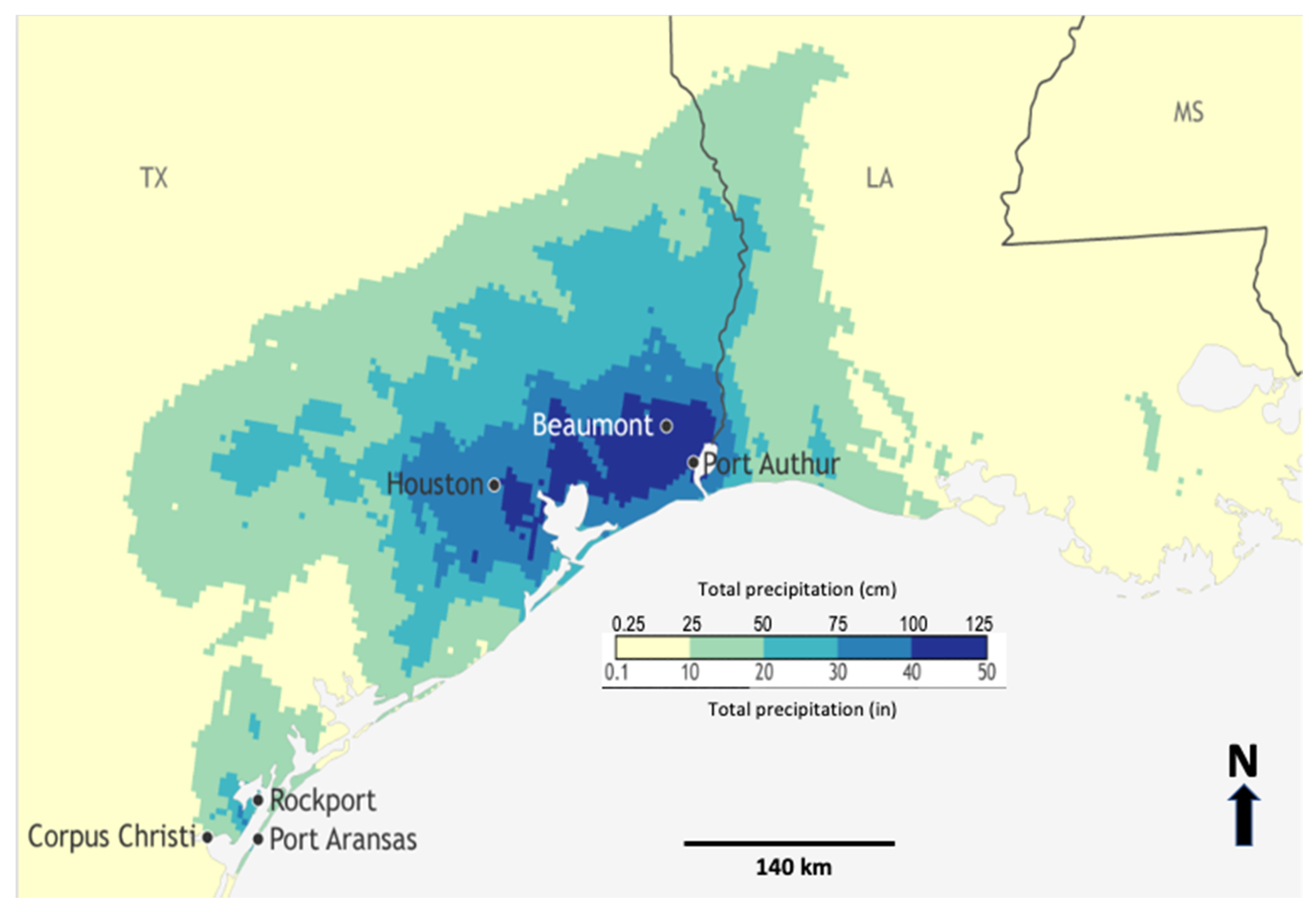
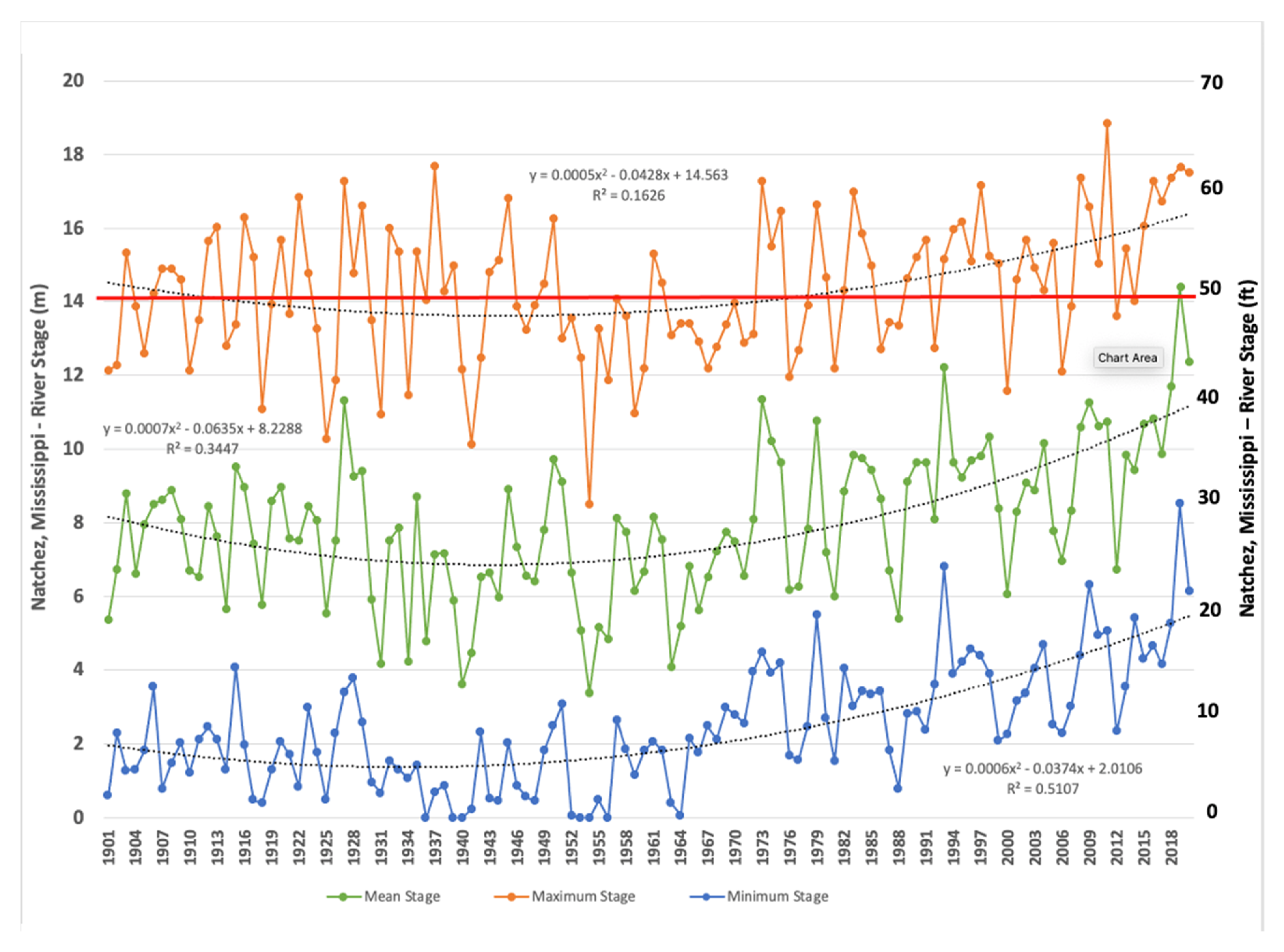
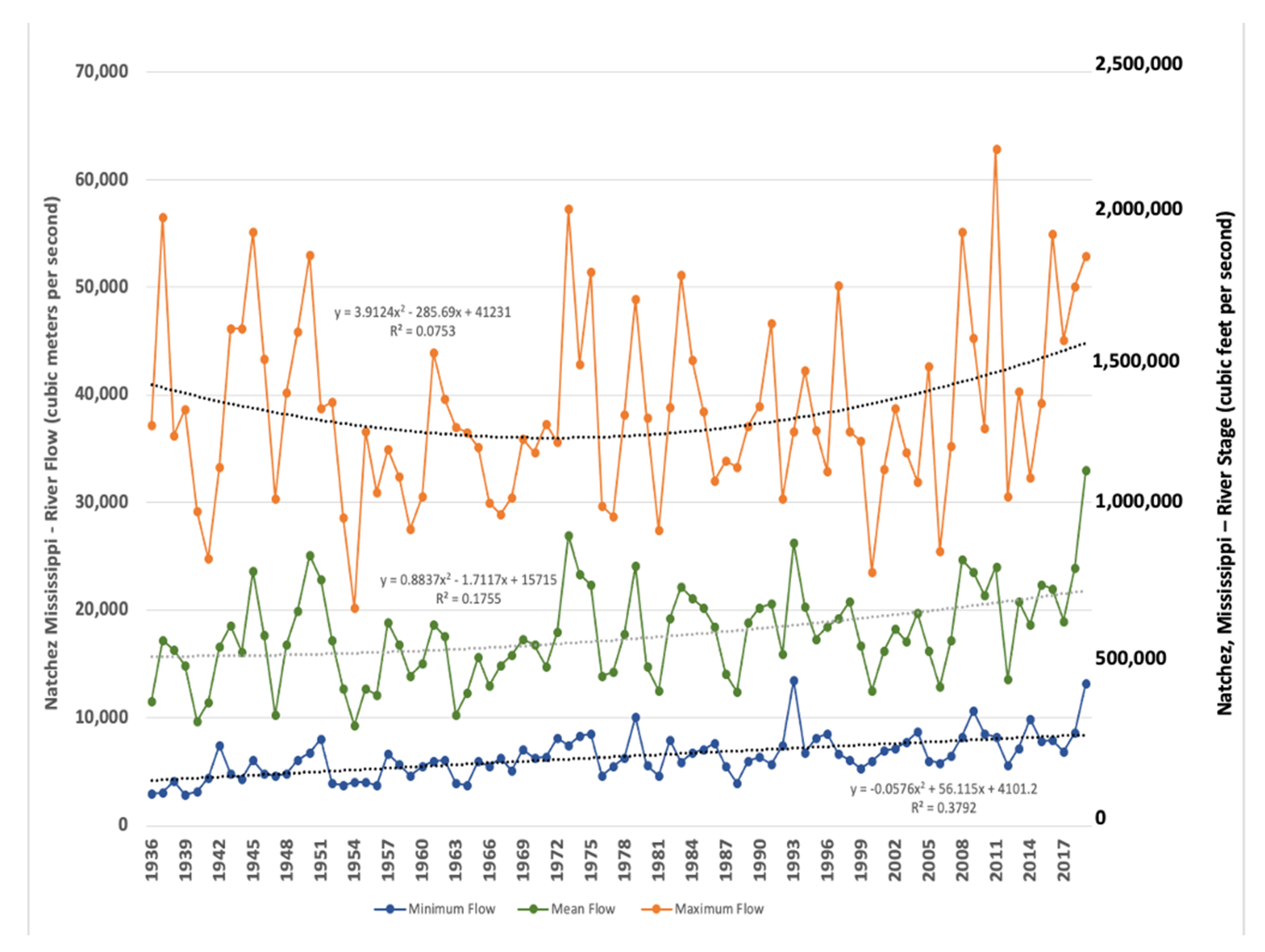
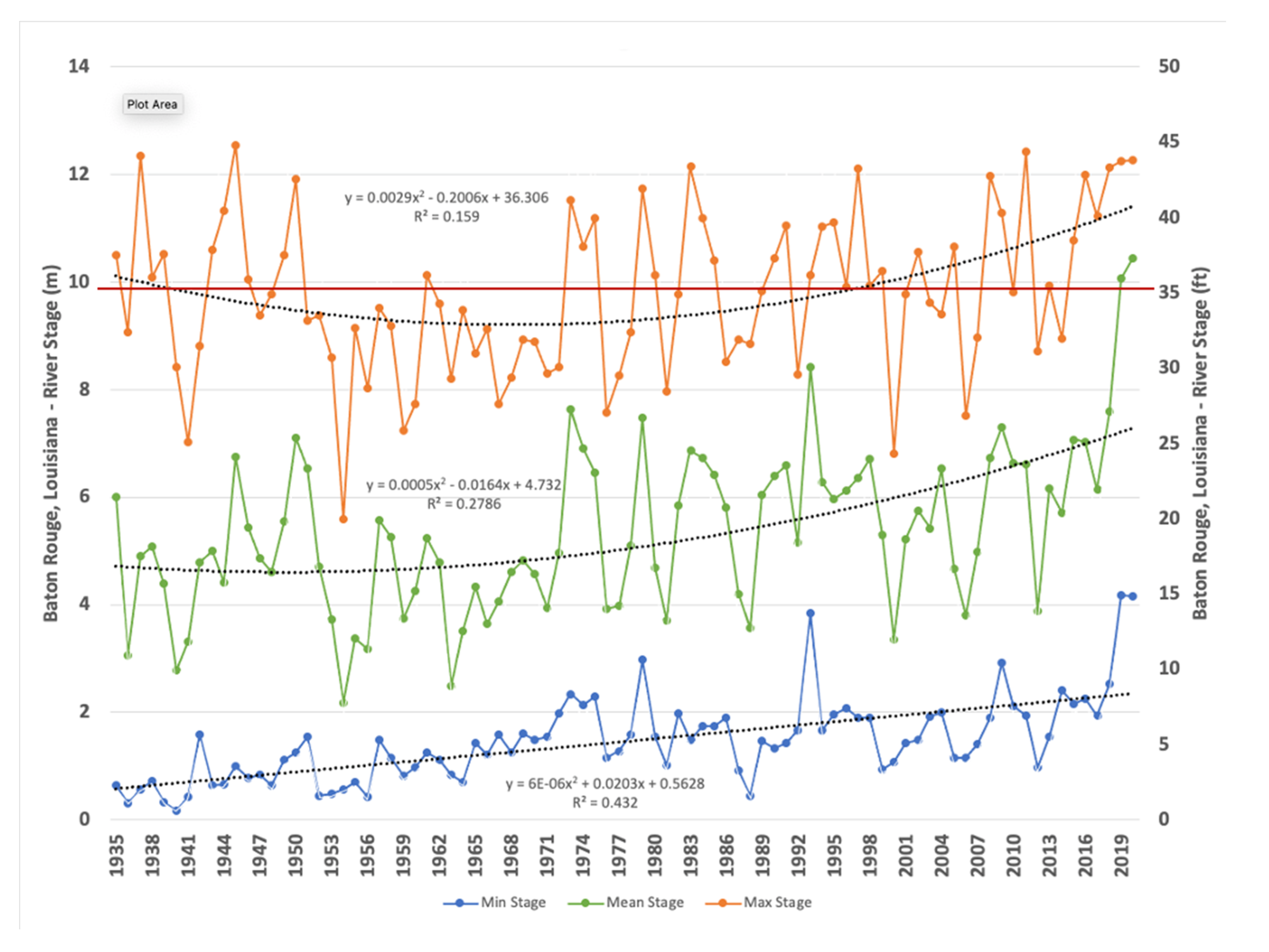
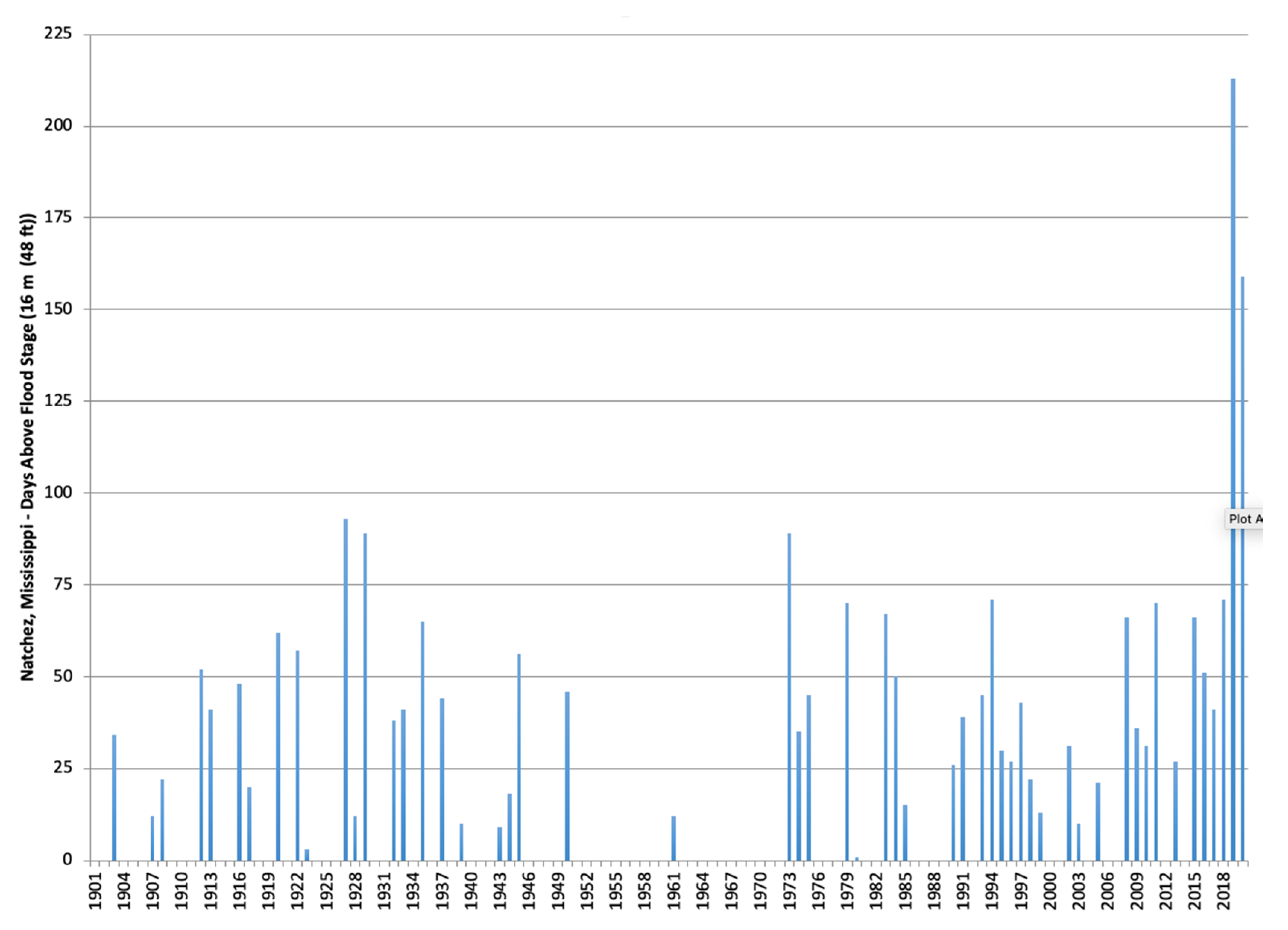
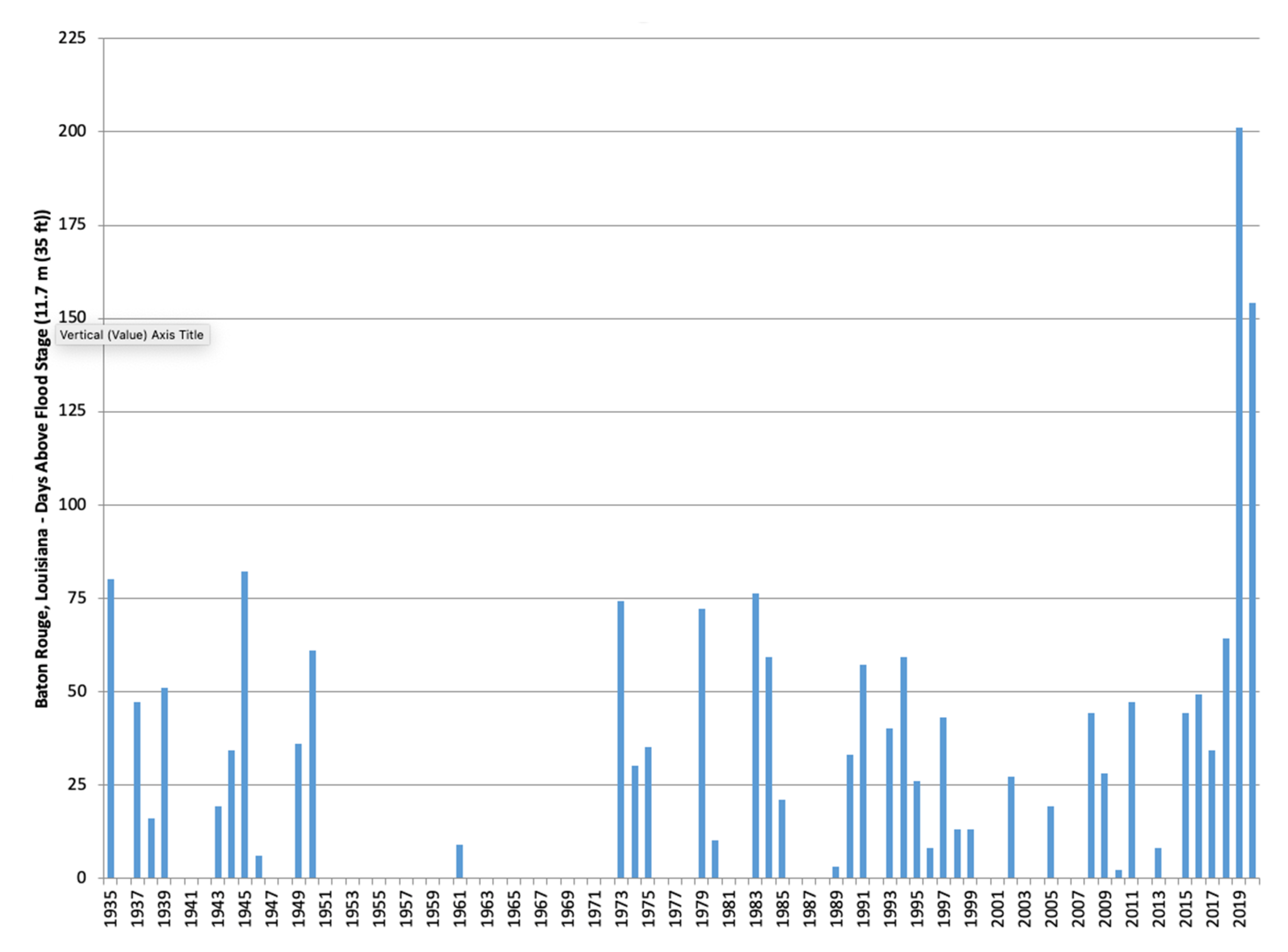
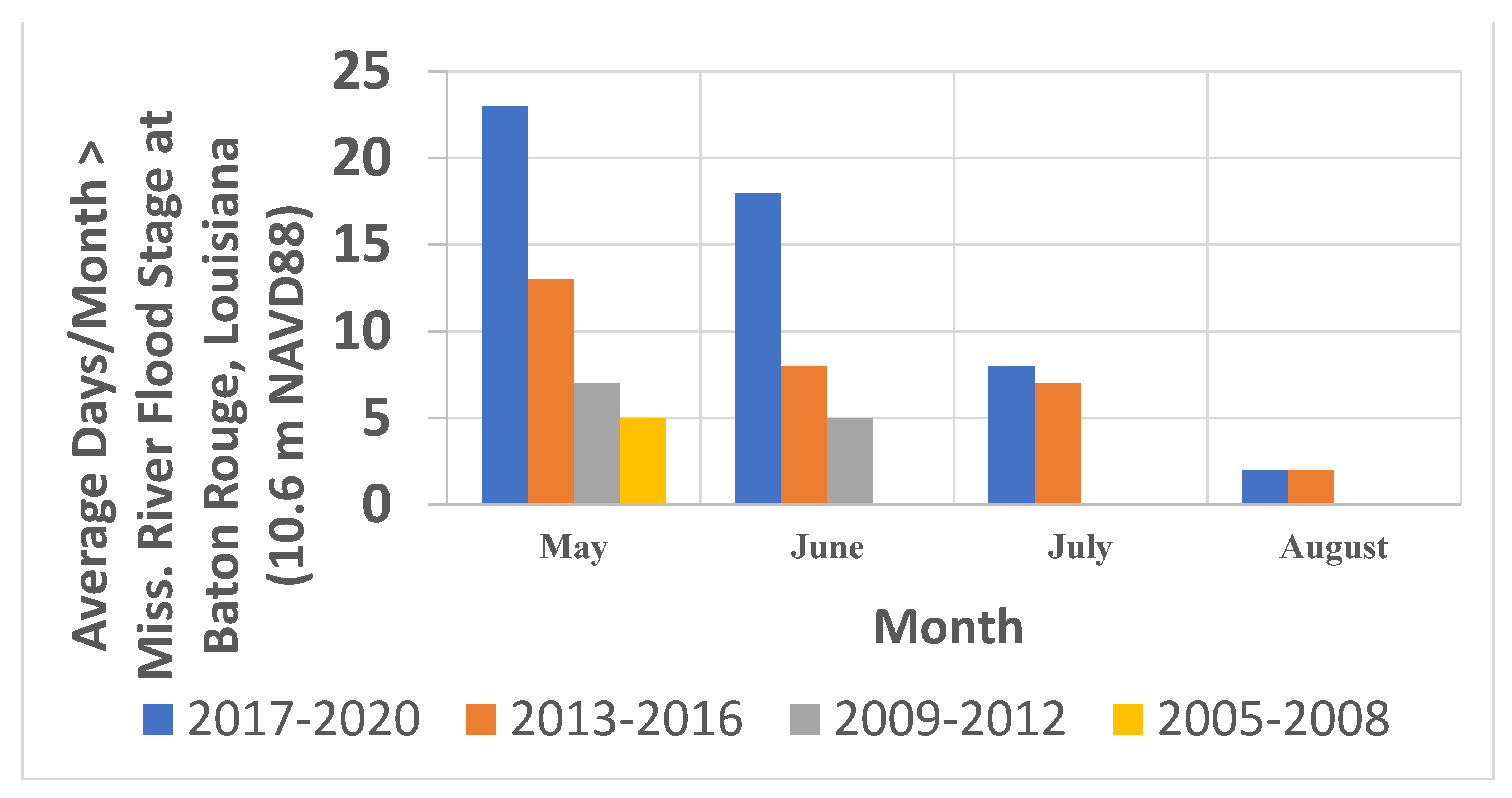
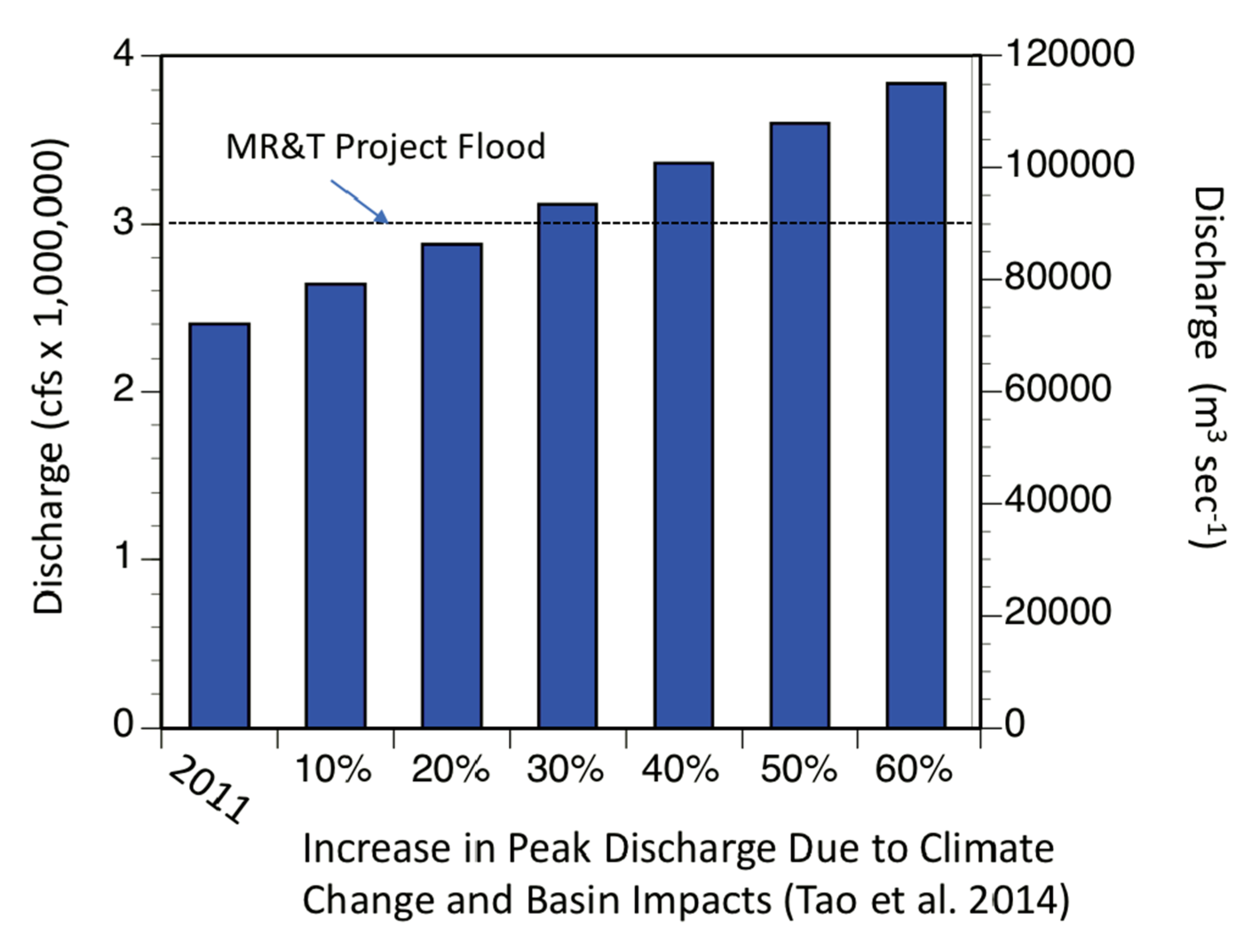
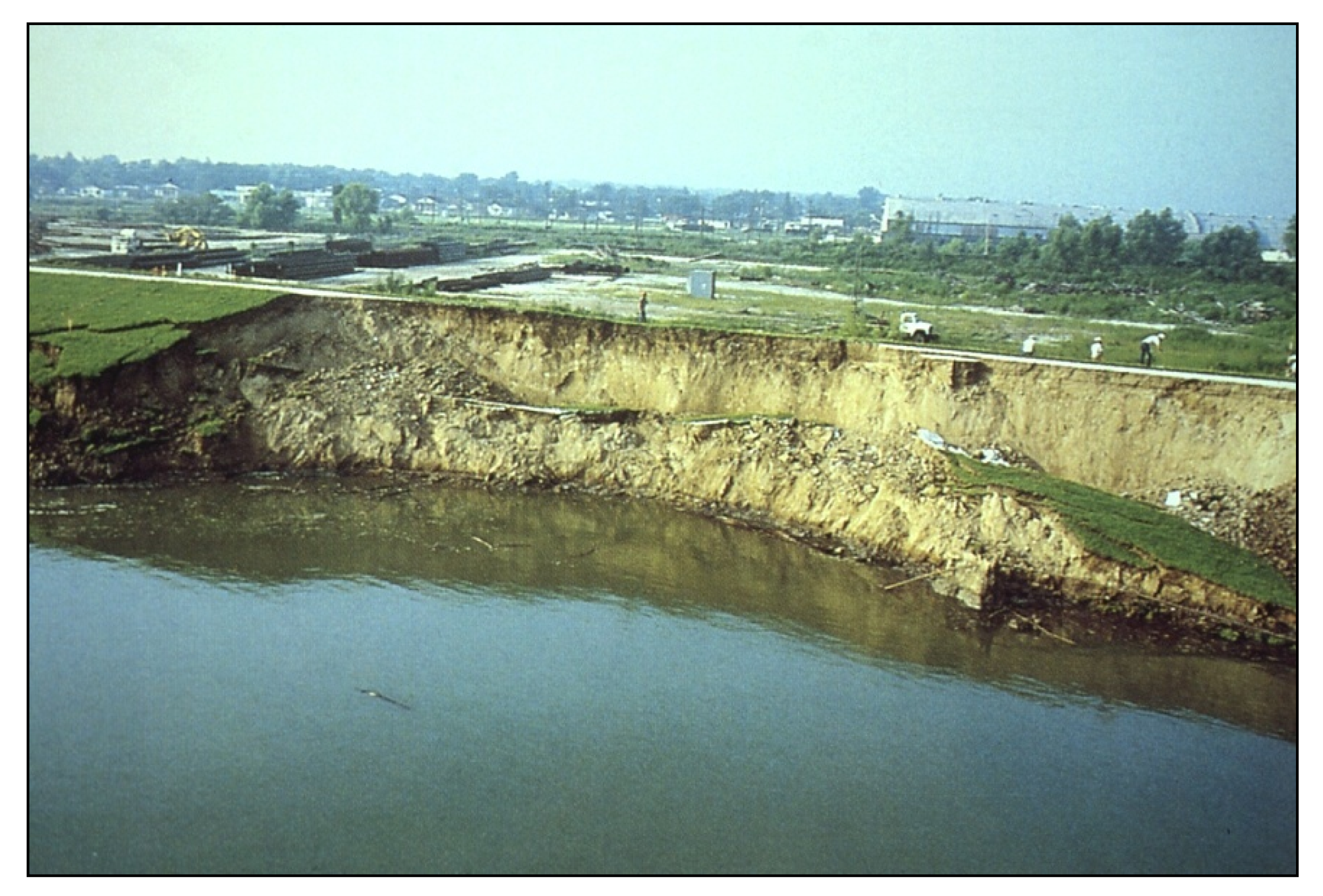
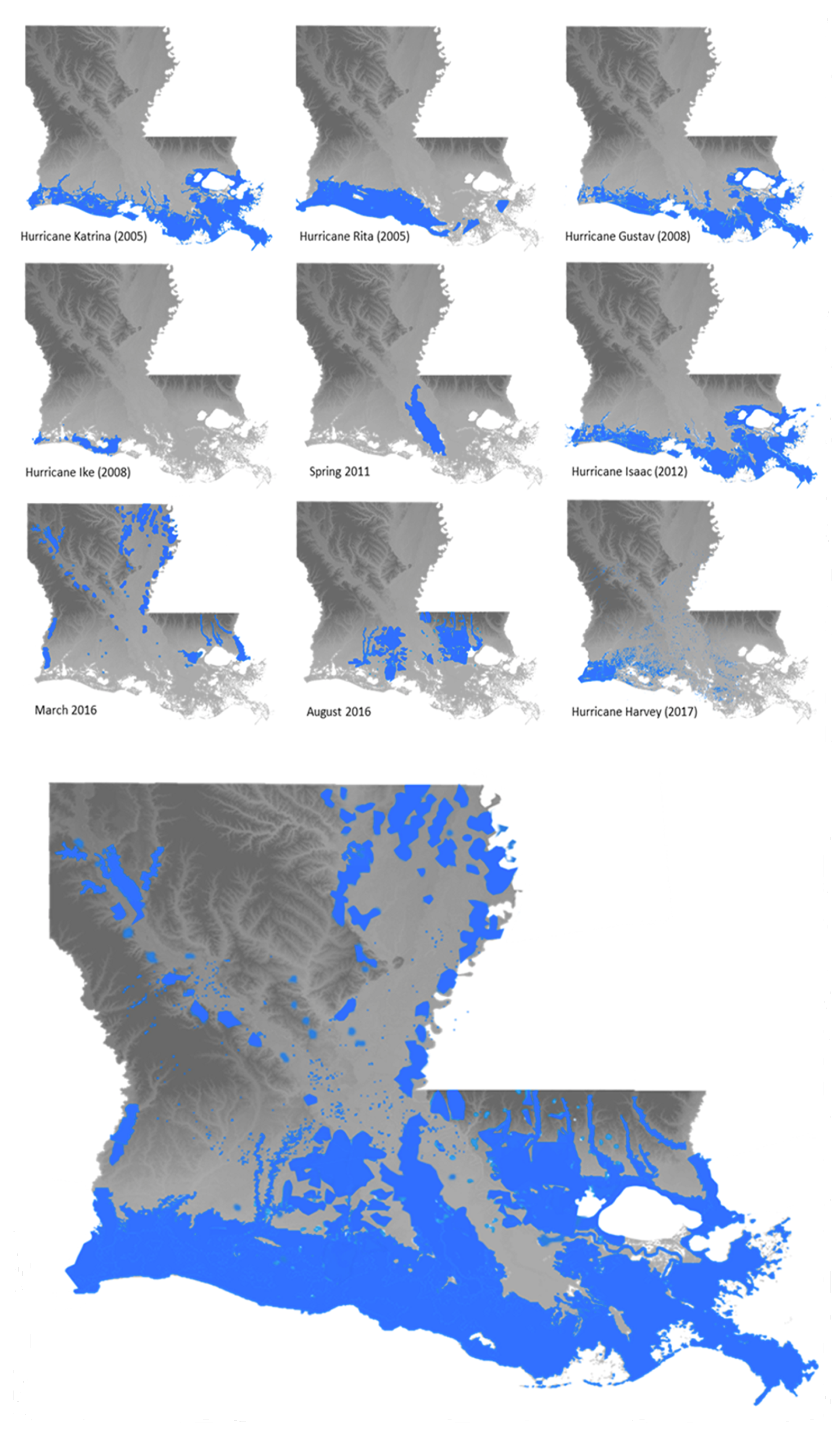
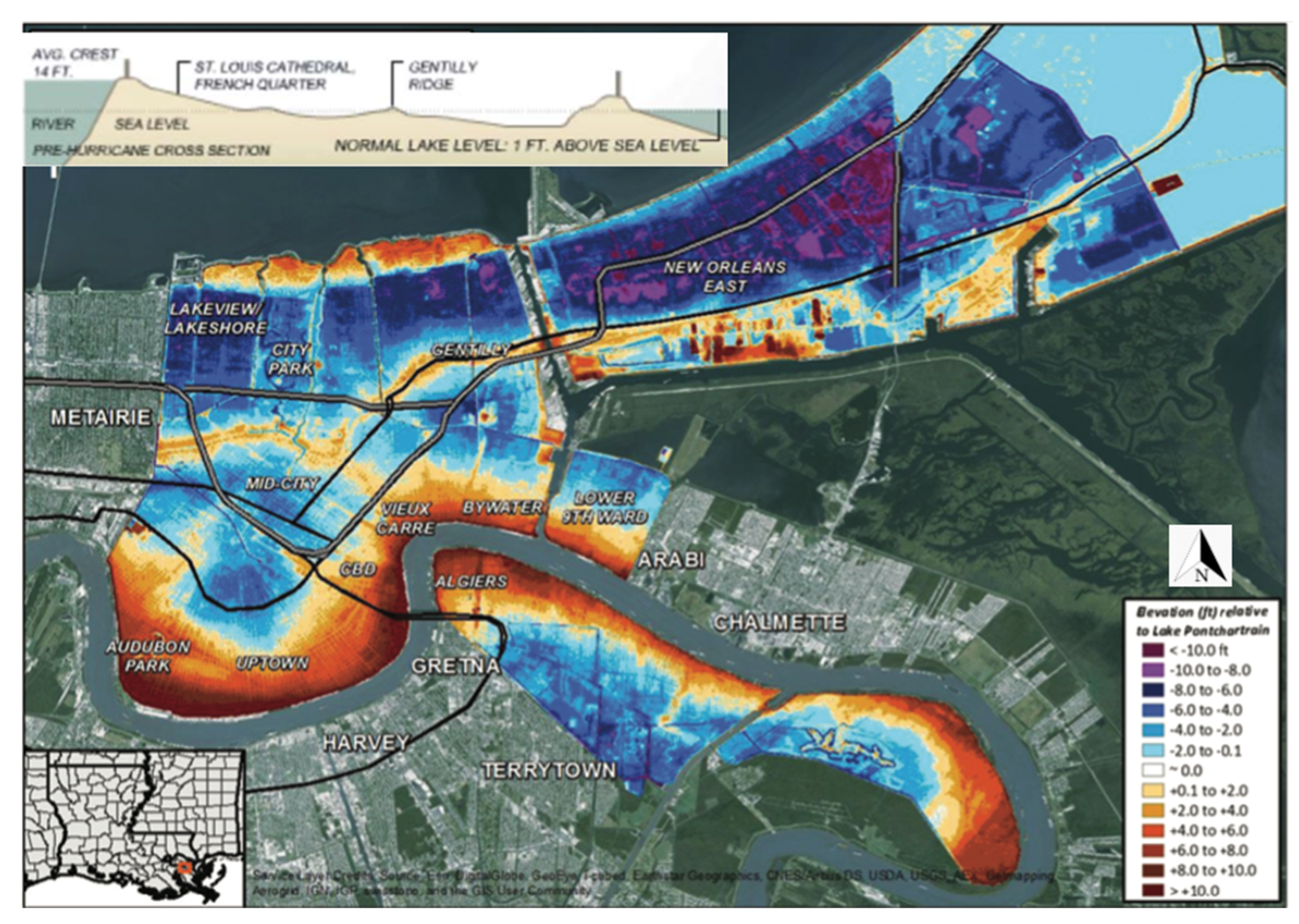
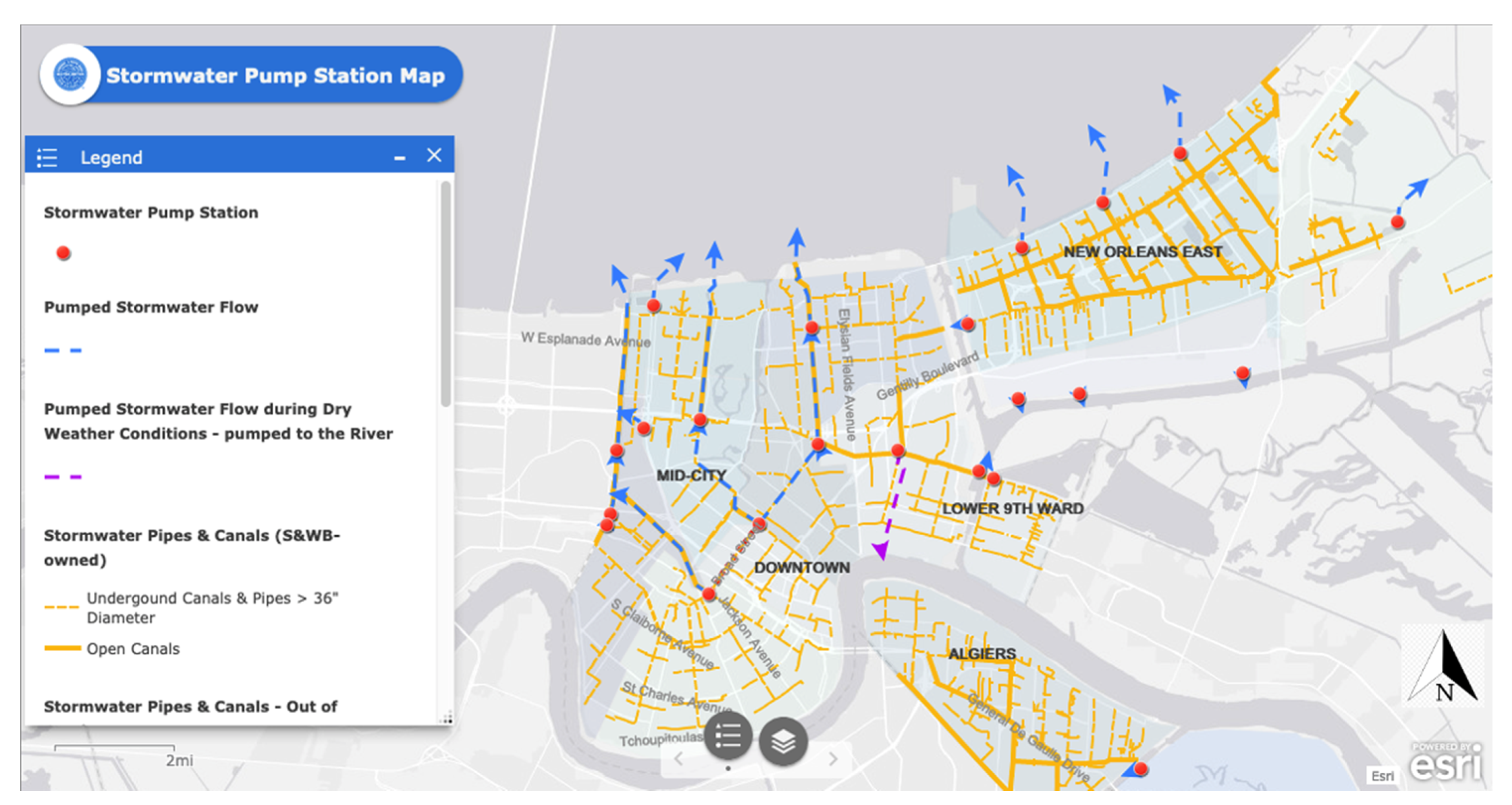

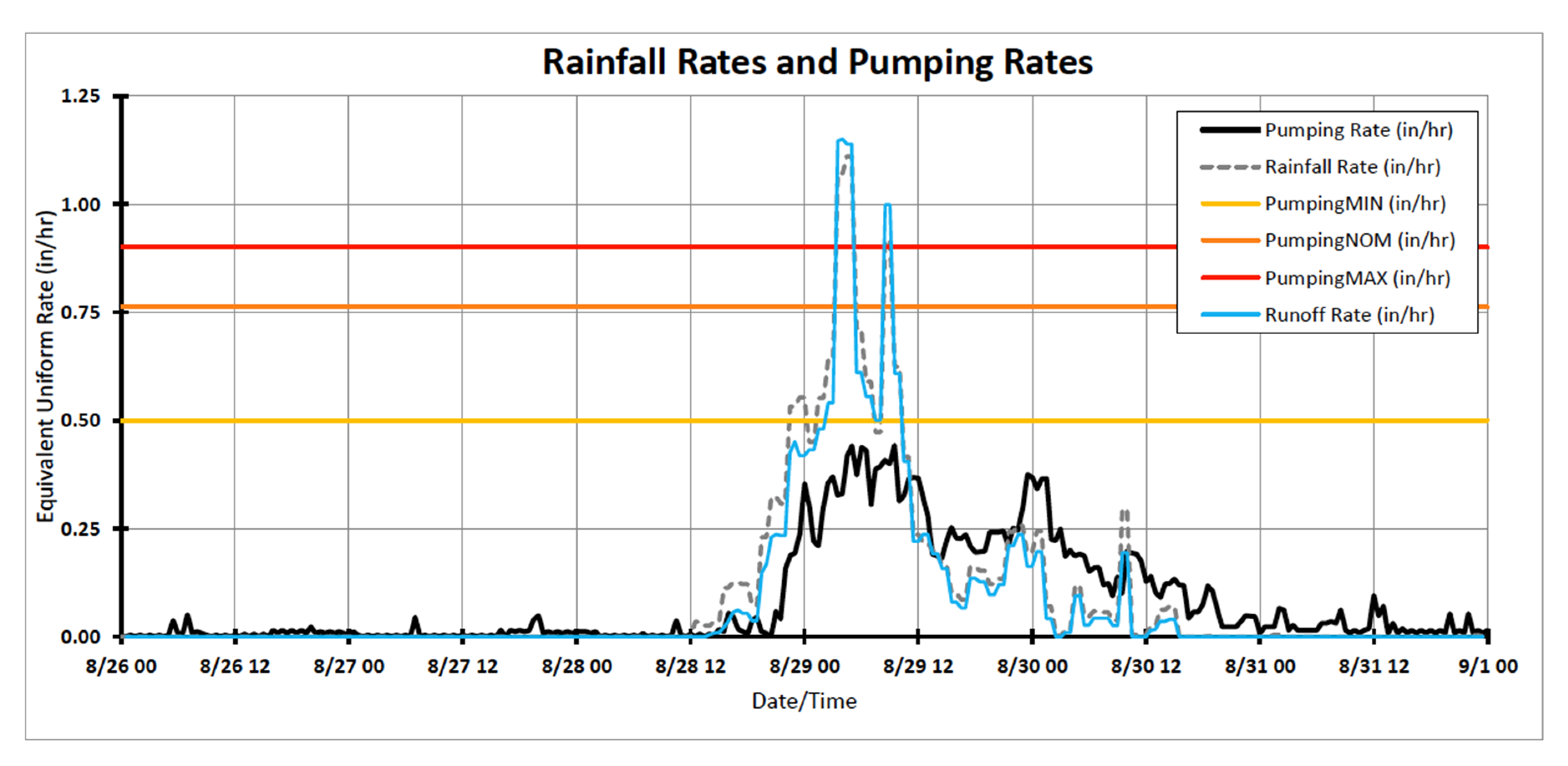
| Event Number | Event | Date | Landfall Location | Parishes with Flooding |
|---|---|---|---|---|
| 1 | Tropical Storm Allison | June 2001 | Morgan City, LA | Cameron, St. Tammany, St. Bernard, E. Baton Rouge |
| 2 | Tropical Storm Bertha | August 2002 | Mouth of MS River | St. Tammany, E. Feliciana |
| 3 | Hurricane Isidore | September 2002 | Grand Isle, LA | St. Tammany, upper Jefferson |
| 4 | Hurricane Lili (Cat 1) | October 2002 | Vermillion Bay, LA | Vermillion, Acadia |
| 5 | Tropical Storm Bill | June 2003 | Central LA Coast | Terrebonne, St. Tammany |
| 6 | Hurricane Ivan | September 2004 | Cameron, LA | Cameron, Calcasieu, Caddo |
| 7 | Tropical Storm Matthew | October 2004 | Central LA coast at Frenier, LA | Terrebonne, Lafourche |
| 8 | Hurricane Cindy (Cat 1) | July 2005 | Grand Isle, LA | Orleans |
| 9 | Hurricane Katrina (Cat 3) | August 2005 | Mouth of MS River | Most coastal parishes |
| 10 | Hurricane Rita (Cat 3) | September 2005 | LA-TX border | Vermillion, Cameron, Calcasieu, Vernon, Beauregard, Jefferson Davis, Allen |
| 11 | Western/Northern River flood | October 2006 | Not applicable | Vernon, St. Landry, Calcasieu |
| 12 | Hurricane Humberto (Cat 1) | September 2007 | Vinton, LA | Lafayette, Beauregard |
| 13 | Tropical Storm Edouard | August 2008 | Gilchrist, TX | Calcasieu |
| 14 | Hurricane Gustav (Cat 2) | September 2008 | Mouth of MS River | Most coastal parishes |
| 15 | Hurricane Ike (Cat 1) | September 2008 | Point Bolivar, TX | Cameron, Vermillion |
| 16 | Tropical Storm Bonnie | July 2010 | Mouth of MS River | Washington, W. Baton Rouge |
| 17 | Tropical Depression 5 | August 2010 | LA-MS border | Orleans, Avoyelles |
| 18 | MS and Atchafalaya rivers flood | April 2011 | Not applicable | Avoyelles, Iberville, W. Baton Rouge, Pointe Coupee, Iberia |
| 19 | Tropical Storm Lee | September 2011 | Vermillion Bay, LA | St. Tammany, Orleans, Plaquemines, St. Bernard, Jefferson |
| 20 | Hurricane Isaac (Cat 1) | August 2012 | Port Fourchon, LA | Most coastal parishes |
| 21 | Red River flood | June 2015 | Not applicable | Caddo, Bossier, Natchitoches, Rapides |
| 22 | MS River flood | January 2016 | Not applicable | W. Baton Rouge, W. Feliciana, Pointe Coupee |
| 23 | Northern LA rivers flood | March 2016 | Not applicable | Tangipahoa, St. Tammany, Washington, Livingston, Ascension, Calcasieu, Beauregard, Vernon, Ouachita, Caldwell, Richland, Madison, Bienville, Natchitoches |
| 24 | Eastern LA rivers flood | August 2016 | Not applicable | Ascension, Livingston, E. Baton Rouge, W. Baton Rouge, Tangipahoa, St. Helena, Rapides, Pointe Coupee, Vermillion, Acadia, Evangeline, St. Martin |
| 25 | Tropical Storm Cindy | June 2017 | LA-TX border | Cameron, Calcasieu, Vermillion, Iberia |
| 26 | Hurricane Harvey | August 2017 | Cameron, LA | Cameron, Jefferson Davis, Acadia, Vermillion, St. Martin, Acadia, Lafayette, Calcasieu, Iberia, Terrebonne |
| 27 | Red River Flood | March 2018 | Not applicable | Natchitoches, Bossier, Caddo |
| 28 | Hurricane Nate (Cat 1) | October 2017 | Mouth of MS River | St. Tammany |
| 29 | Hurricane Barry (Cat 1) | July 2019 | Marsh Island, LA | St. Martin, Terrebonne, Lafourche |
| 30 | Tropical Storm Olga | October 2019 | Central LA coast | Terrebonne, Lafourche, St. Tammany |
| 31 | Tropical Storm Cristobal | June 2020 | SE LA | Jefferson |
| 32 | Tropical Storm Marco | August 2020 | Mouth of MS River | No major flooding in LA |
| 33 | Hurricane Laura (Cat 4) | August 2020 | LA-TX border | Cameron, Calcasieu |
| 34 | Hurricane Delta (Cat 2) | August 2020 | LA-TX border | Cameron, Calcasieu |
| 35 | Hurricane Zeta (Cat 2) | October 2020 | Cocodrie, LA |
Publisher’s Note: MDPI stays neutral with regard to jurisdictional claims in published maps and institutional affiliations. |
© 2021 by the authors. Licensee MDPI, Basel, Switzerland. This article is an open access article distributed under the terms and conditions of the Creative Commons Attribution (CC BY) license (http://creativecommons.org/licenses/by/4.0/).
Share and Cite
Day, J.W.; Hunter, R.; Kemp, G.P.; Moerschbaecher, M.; Brantley, C.G. The “Problem” of New Orleans and Diminishing Sustainability of Mississippi River Management—Future Options. Water 2021, 13, 813. https://doi.org/10.3390/w13060813
Day JW, Hunter R, Kemp GP, Moerschbaecher M, Brantley CG. The “Problem” of New Orleans and Diminishing Sustainability of Mississippi River Management—Future Options. Water. 2021; 13(6):813. https://doi.org/10.3390/w13060813
Chicago/Turabian StyleDay, John W., Rachael Hunter, G. Paul Kemp, Matthew Moerschbaecher, and Christopher G. Brantley. 2021. "The “Problem” of New Orleans and Diminishing Sustainability of Mississippi River Management—Future Options" Water 13, no. 6: 813. https://doi.org/10.3390/w13060813
APA StyleDay, J. W., Hunter, R., Kemp, G. P., Moerschbaecher, M., & Brantley, C. G. (2021). The “Problem” of New Orleans and Diminishing Sustainability of Mississippi River Management—Future Options. Water, 13(6), 813. https://doi.org/10.3390/w13060813







